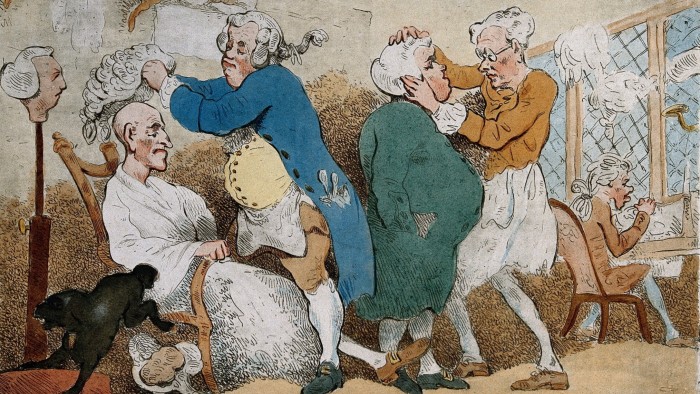Unlock the Editor’s Digest for free
Roula Khalaf, Editor of the FT, selects her favourite stories in this weekly newsletter.
One night three years ago, Gary Groom arrived early at a restaurant in Yarm in North Yorkshire and watched as his friends walked straight past. “Not one gave me a second look.” Finally, he joined them. “As soon as I opened my mouth, they all went, ‘What?’ They wanted to get up close and look at the hairline.”
Groom, who started to bald at 14, had a full head of hair for the first time in his adult life courtesy of a non-surgical “hair replacement system” — a 21st-century upgrade on the toupee.
“Back in the day, this kind of thing wasn’t available,” says the 61-year-old. He had previously thought about a hair transplant but was told he wasn’t a suitable candidate. “I’ve only got a small amount of hair at the back — the egg in a bun look.”
Hair pieces, also known as hair systems, offer a cheaper, less invasive solution. Sometimes described as a semi-permanent wig, the system involves artificial or real hair applied to the head with an adhesive that is scrubbed off after three to four weeks and reapplied.
After watching TikTok posts of Rob Wood, the owner of Novo Cabelo hair system, transforming clients’ appearances, Groom decided to give it a try.
In doing so, the retired college principal joins a growing number of British men willing to be open about their cosmetic procedures. The England cricket captain, Ben Stokes, got a hair transplant after seeing himself on TV. “It was the first thing I would see when I watched footage of myself on the cricket field bowling,” he said. “When you’re bowling [the cameras are] above you.”
British men have a particular propensity for baldness. One study puts the UK fifth in a hair loss league, topped by the Czech Republic and behind France.
A medical cure remains elusive. But instead of accepting their fate, more men are seeking preventive treatment like the medication finasteride, transplant surgery (which has created a niche tourism boom in Turkey) and hair systems.
According to market research company Euromonitor, the global hair loss treatment market was close to $1bn in 2019 and is forecast to reach $1.6bn in 2026. Uptake, once strongest among middle-aged men, has shifted to younger generations looking to address signs of ageing from the onset.
Glen Jankowski, a researcher on the topic, writes that the 20th century transformed the perception of baldness “from a benign aesthetic to a disadvantageous disease in need of ‘cure’”.
Across politics, business and entertainment, baldness is rarely seen beyond a few standout figures, such as Vin Diesel and Jeff Bezos. One US study found that among white male CEOs, significant hair loss was less common than for the wider population. This number could dwindle further as treatments move further into the mainstream.
Ash Hashim, co-founder of Dense, a preventive treatment company, thinks many men already feel under pressure to have a “perfect” hairline. “Men tease each other under the guise of ‘banter’,” he says. “Social media constantly showcases models with seemingly perfect hair and bodies — often edited or filtered. It can create an unrealistic standard.”
But Wood, who set up his hair system company in 2020, says he has seen a positive shift in the way in which men are more open about their desire to alter their appearance. “The men’s grooming industry is growing, catching up with women now. People are willing to be filmed, talk[ing] about how they feel about hair loss.” This is part of a broader opening of private lives — women, too, are increasingly open about their use of hair pieces and extensions.
The ability to work from home may also be a factor in the uptake of tweaks to physical appearance, particularly invasive hair transplants. “It helps people not take two weeks off,” says Christopher D’Souza, president of the British Association of Hair Restoration Surgery and a hair transplant surgeon.
Groom is happy to stick with his hair system. “It’s more about comfort in my own skin. I’m happy with how I look.” The only time he can’t look at himself is when he goes to get the hair replaced. “I think, ‘’Who’s that old man?’ I don’t relate to the bald me.”
Read the full article here

